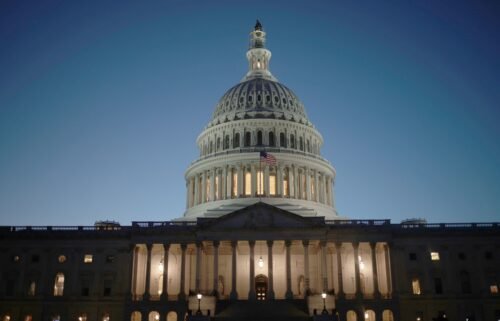Dissents from the bench: A Supreme Court tradition missing during Covid

By Joan Biskupic, CNN legal analyst & Supreme Court biographer
The Covid pandemic deprived the Supreme Court of its courtroom for oral arguments, its intimate conference room for deliberations and, as is evident these days, the bench where dissenting justices can vent.
At the end of each Supreme Court session, individual justices on the losing side of a case often find that a written dissent is not enough. They feel compelled to read excerpts from the tall mahogany bench and rhetorically grab courtroom spectators by the collar to convince them of the majority’s wrongheadedness.
History unfolds on these occasions, as when Justice Sonia Sotomayor gave voice to her experience as the first Latina justice, or when Chief Justice John Roberts decried a right to same-sex marriage while a swelling crowd outside the court cheered loudly. The late Justice Ruth Bader Ginsburg wore a special collar, black with small jewel accents, over her robe for those times when she slowly but clearly read her dissent aloud.
These gripping moments of anger and frustration flesh out the robe-clad justices, usually loath to reveal themselves beyond their opinions. As much as the words, it’s the pitch of a voice and intensity of facial expressions, including what’s seen of fellow justices along the bench.
But the drama ended when the building was shuttered.
Earlier this month, when the Supreme Court left Obamacare in place for the third time, Justice Samuel Alito was livid. In a non-Covid world, he might have read portions of his dissent from the courtroom bench. That’s what lead dissenters did in the prior Obamacare controversies, in 2012 and 2015.
Nine years ago, when Justice Anthony Kennedy protested the first decision upholding the Affordable Care Act, his face reddened as he spoke, finding that “The Act before us is invalid in its entirety.”
Since March 2020 the justices have been largely out of sight, leaving the public with few glimpses of their mysterious inner world. Thursday, they will finish their 2020-21 calendar with opinions on Arizona voting regulations and California disclosure requirements for charitable contributions that could have national reverberations.
Alito’s written dissent in the recent Obamacare case was sufficiently potent to draw attention in news stories and on social media, particularly his assertion, “Today’s decision is the third installment in our epic Affordable Care Act trilogy, and it follows the same pattern … with the Affordable Care Act facing a serious threat, the Court has pulled off an improbable rescue.”
But Alito’s voice, inflected by his New Jersey roots, went unheard, unlike five years ago, for example, when he dissented from the bench in a Texas abortion case, Whole Woman’s Health v. Hellerstedt: “We have no authority to strike down perfectly valid provisions of state law.”
Even seeing what issues prompt each justice to speak from the bench can enhance public understanding of the nine. Sotomayor offered her first such dissent in a 2014 controversy over a Michigan ballot initiative that foreclosed racial affirmative action in public policies.
“My colleagues fundamentally misunderstand the nature of the injustice,” Sotomayor said of the Michigan measure that prevented any lobbying for race-based admissions. “The right way to stop discrimination on the basis of race is to speak openly and candidly on the subject of race and to apply the Constitution with eyes open to the unfortunate effects of centuries of racial discrimination.”
In 2015, Roberts used his first and only oral dissent to protest the majority’s decision declaring a right to same-sex marriage: “From the dawn of human history until a few years ago for every people known to have populated this planet, marriage was defined as the union of a man and a woman.”
He continued: “If you are among the many Americans — of whatever sexual orientation — who favor expanding same-sex marriage, by all means celebrate today’s decision. … But do not celebrate the Constitution. It had nothing to do with it.”
Fireworks and eye rolls
Before the Supreme Court closed its columned building as part of the nationwide response to the coronavirus pandemic, the justices took the bench to release rulings. First, the author of the majority opinion would read excerpts. The recitations were straightforward fare of the bottom-line judgment, some legal reasoning and the vote.
Any fireworks came with the occasional dissent. Rarely would a justice undertake an oral dissent more than once a session. Ginsburg, however, offered three in late June 2013, including in the consequential voting rights case of Shelby County v. Holder. In a separate 2013 dispute, over the reach of job-discrimination law, as she was reading her dissent, Alito grew irritated and rolled his eyes.
He had written the majority opinion, and he grimaced as she concluded, “Today, the ball again is in Congress’ court to correct this Court’s wayward interpretations of Title VII.” Alito’s prickly response added to the drama and the day’s news coverage and public commentary.
Another unexpected moment of theater occurred during bench announcements in a capital punishment case in June 2015, as the majority rejected defendants’ challenge to a method of lethal injection.
First, Alito announced the majority decision, including details of the “exceptionally heinous murders” by the men who had brought the case. Then Sotomayor read portions of her dissent related to the injection drugs and to constitutional protections against cruel and unusual punishment. Then Breyer, also dissenting, told spectators that he and Ginsburg wanted a full reconsideration of whether the death penalty itself was constitutional.
That last suggestion riled Scalia and he decided to speak out. He had joined the Alito majority and was not protesting the judgment. Scalia’s remarks revealed his sentiment regarding the Breyer-Ginsburg suggestion, yet also showed that he was still fuming over the decision that session declaring a constitutional right to same-sex marriage.
“Last Friday five justices took the issue of same-sex marriage away from the people,” he said, “on the basis of nothing but their own policy preferences. … Maybe we should celebrate the fact that two justices are willing to kill the death penalty outright instead of pecking it to death, as has been the case.”
That set of bench readings in Glossip v. Gross took nearly 25 minutes. On Thursday, when decisions go online, all competing views in a case will be revealed in seconds, in mere black and white text.
The Supreme Court has not yet announced whether it will resume public courtroom sessions for the term that begins next October. Perhaps the end of that 2021-22 session will bring a return of vivid dissents from the bench.
The last such pre-pandemic moment occurred in June 2019, when a 5-4 Roberts-led majority said federal judges have no authority to review partisan gerrymanders drawn by legislatures to entrench one political party over a rival.
“The practice amounts to rigging elections,” Justice Elena Kagan said, speaking for a total of 13 minutes. As she concluded, her voice seemed to crack with emotion.
“The majority just says it can’t do anything about the problem,” she said. ” … And of all times to abandon the Court’s duty to declare the law, this was not the one. The practices challenged in these cases imperil our system of government. Part of the Court’s role in that system is to defend its foundations. None is more important than free and fair elections. With respect, but deep sadness, Justices Ginsburg, Breyer, Sotomayor and I dissent.”
The-CNN-Wire
™ & © 2021 Cable News Network, Inc., a WarnerMedia Company. All rights reserved.


